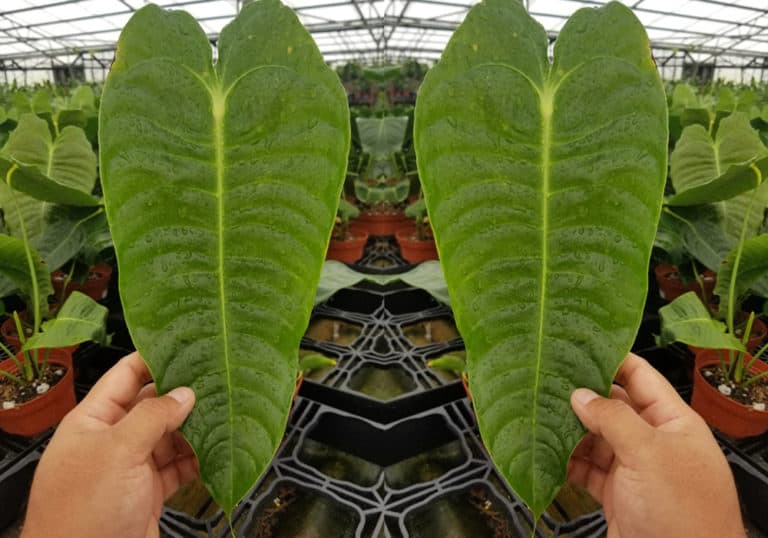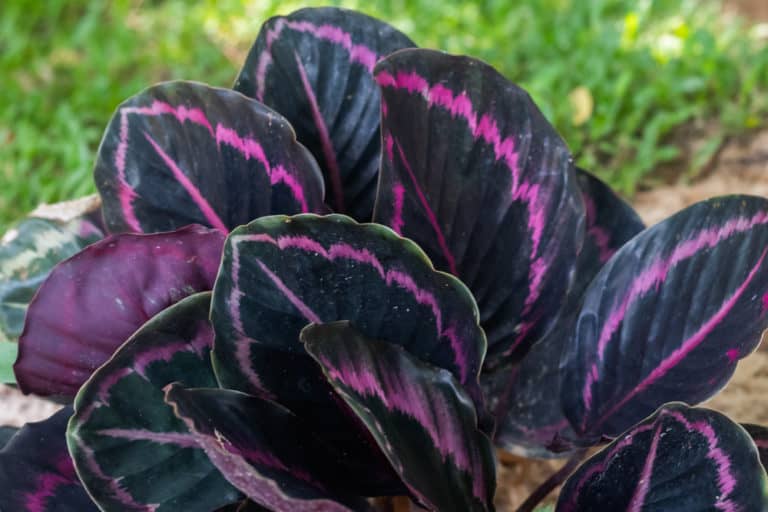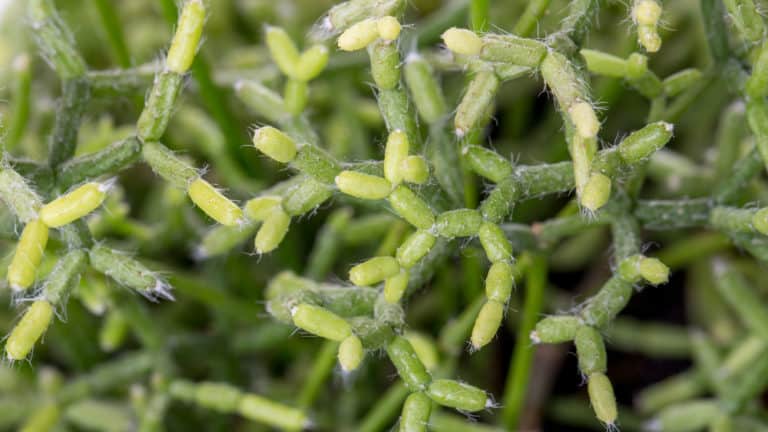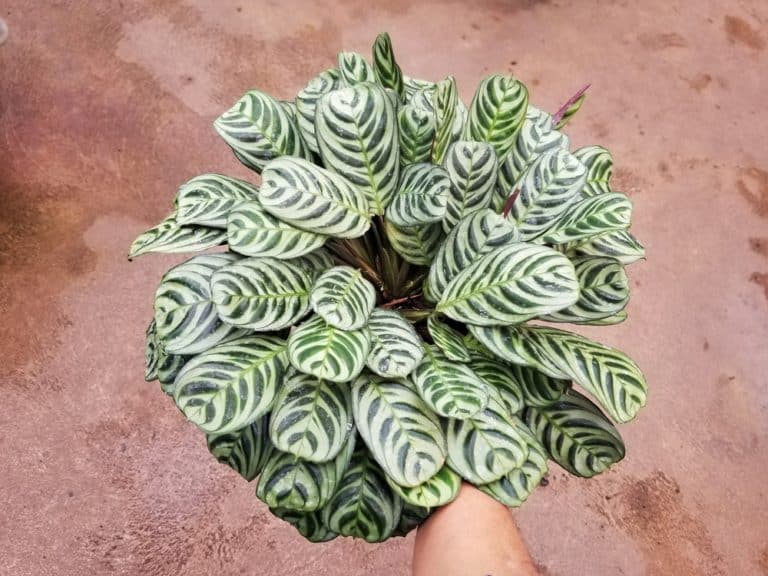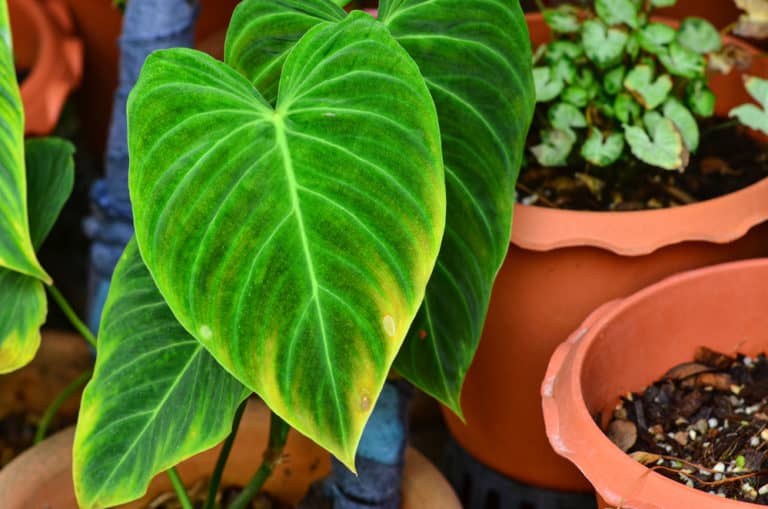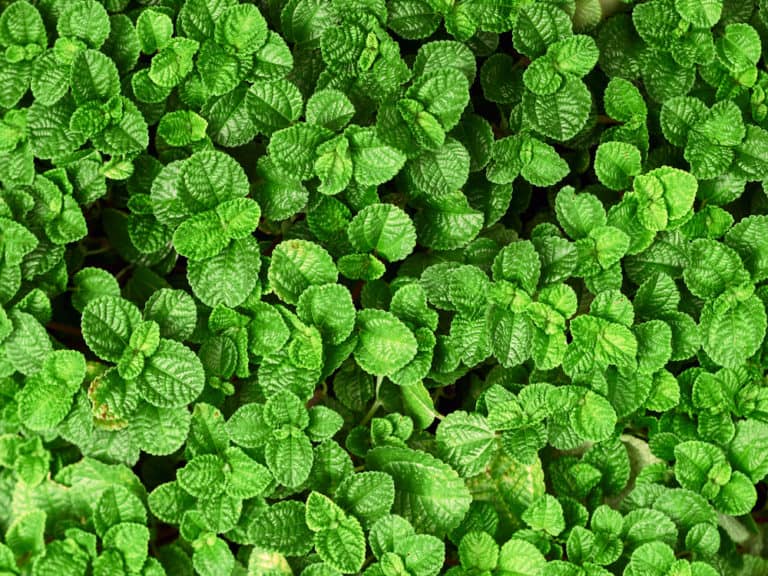Peperomia Prostrata ‘String of Turtles’ Care Guide (2024)
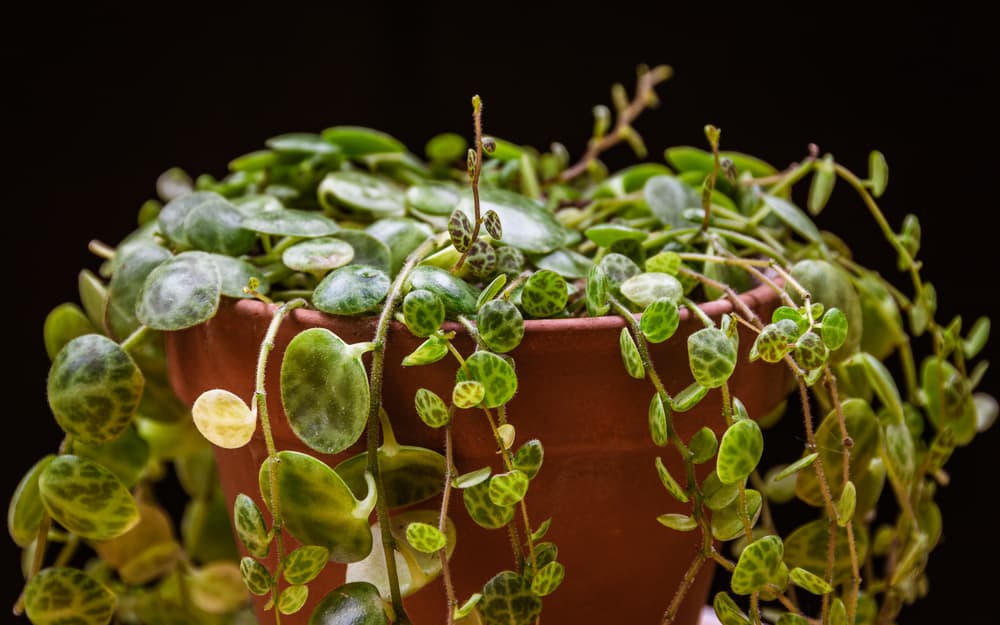
String of Turtles is a lovely little tropical native that’s perfect for tucking into even the smallest of spaces.
As a bonus, Peperomia prostrata is non-toxic, making it a great plant to grow in homes with pets and children.
It’s a non-demanding houseplant that’s perfect for beginner gardeners and experts alike.
| Scientific Name | Peperomia prostrata |
| Common Name | String of Turtles, Magic Marmer, Jade Necklace |
| Light | Bright indirect sunlight |
| Watering | Water if the top two inches of soil are dry |
| Temperature | 65 to 85ºF (18 to 29ºC) |
| Hardiness Zone | 10 to 12 |
| Humidity | 60 to 90% |
| Soil Type | Rich, quick-draining, loamy |
| Soil pH | 5 to 7 (acidic to neutral) |
| Fertilizing | A balanced feed twice a month in spring and summer |
| Repotting | Every 3 years |
| Pruning | As needed to shape plant |
| Propagation | Root in water or soil |
| Toxicity | Not toxic to humans and pets |
| Mature Size | Stems 12 to 24 inches long as a houseplant |
| Bloom Time | Year-round |
What’s Unique About String of Turtles?
The String of Turtles plant is native to the steamy tropical rainforests of Ecuador and Brazil. It has been grown as a houseplant since it was first discovered in the late 1800’s.
String of Turtles plants are prized for their tiny leaves with the shape and markings of miniature turtle shells. The leaves are densely spaced along the delicate stems that trail down.
Growing String of Turtles is easy, as it has very few requirements to stay healthy and thriving.
As well, String of Turtles contributes to your well-being, since its foliage filters contaminants like formaldehyde from the indoor environment.
String of Turtles Care
In the rainforests of South America where String of Turtles originates, this small plant evolved to thrive in the hot, steamy conditions found there.
Your modern home is of course very different, but good String of Turtles plant care is still possible.
For the best Peperomia prostrata care, keep it in as warm and humid an environment as possible.
Light
String of Turtles grows in the shade of the tree canopy in the tropical rainforests, so while it does get some of the bright sun, it’s filtered.
As a result, String of Turtles light requirements are for bright but indirect light, or between 10,000 to 20,000 lux.
Peperomia prostrata light needs are a little pickier than for most tropical plants. The top of the plant needs to receive light, not just the stems that trail downwards.
If you want to set it on a high shelf, you should have a grow light set above it to give it the light it needs.
Otherwise, any spot in a brightly lit space should suit String of Turtles. Just remember not to put it in full sun, which can damage its delicate leaves.
Watering
String of Turtles is a semi-succulent plant that stores water in its leaves and stems, but that does not mean you can skimp on its watering needs.
You should water Peperomia prostrata whenever the top 2 inches of the soil have dried out. Your goal with String of Turtles watering is to maintain consistently moist but not saturated soil.
This may mean 2 to 3 weeks between waterings. Just check the soil every week to see if it’s ready for a drink.
When it’s time to water, slowly pour the water over the whole soil surface, and stop when water starts to run out of the drainage holes.
Temperature
You should not have to do anything special to keep your indoor environment within the acceptable String of Turtles temperature range.
A good temperature for Peperomia prostrata can be anywhere from 65 to 85ºF (18 to 29ºC), so any home with central heating should suffice.
String of Turtles has little temperature tolerance lower than 50ºF (10ºC). Indoors, keep it away from drafts and air conditioners. Don’t keep it too close to windows in really cold winter weather.
It has no frost hardiness at all. If you take it outside in the hot summer, bring it back in well before freezing temperatures arrive.
Humidity
The ideal humidity for Peperomia prostrata is as high as 90%. It is, after all, a native of the steamy tropical rainforests.
In your home, the String of Turtles humidity requirements are not that exacting.
Your String of Turtles will usually grow just fine with a humidity level between 40 to 50%.
However, if you really want to see it thrive, you can give it some extra moisture in the air.
One option is to mist the plants regularly, using distilled water.
You can also keep it in a terrarium, where moisture levels stay high.
Just grouping plants together can create a moister microclimate, but you can augment that with a small humidifier.
Soil
String of Turtles soil must be well-draining, as the plant will not tolerate sitting in wet soil.
The required pH level for Peperomia prostrata is 5 to 7, or acidic to neutral.
While some recommend a commercial cactus or succulent soil for Peperomia prostrata, that isn’t necessarily the best.
You can make your own soil mix by combining peat moss or coconut coir with some well-rotted compost or worm castings.
You could also mix 2 parts peat moss with 1 part perlite.
Another way to provide well-draining soil that will still retain some moisture is to mix equal parts of potting soil and perlite.
Fertilizer
It’s a good idea to use a fertilizer for Peperomia prostrata so that it will grow the lushest foliage possible.
You can use a cactus fertilizer for your String of Turtles fertilizer, with a fertilizer ratio of 0.5-1-1.
However, a standard liquid fertilizer with a 10-10-10 ratio will work fine as well. Dilute it to half the recommended strength.
Whichever you use, only apply the fertilizer right after you’ve watered. Pour it slowly over the entire soil surface to ensure even distribution to the roots.
Use the fertilizer once every two weeks in spring and summer, stopping during String of Turtles’s dormant period in fall and winter.
Potting & Repotting
Because of its slow growth and eventual small size, String of Turtles repotting only needs to be done every 2 or 3 years.
Sometimes potting just needs to be done to refresh the soil, whether it has grown in size or not.
When repotting Peperomia prostrata, only increase the pot size if the roots seem to be crowded. Never go more than 2 inches larger in width, as too large a pot can stress the plant.
An unglazed clay pot is a good choice for String of Turtles, as it will keep the soil from retaining too much water.
Good drainage holes are a must, as the soil cannot be saturated with water.
Pruning
String of Turtles pruning should be done to keep the stems from getting too leggy and unkempt.
You should also trim out any dead or damaged leaves, as they mar the appearance and can harbor disease or attract pests.
When cutting Peperomia prostrata stems, cut just below a node to encourage branching to increase the bushiness of your plant.
Always use sharp, sterilized scissors to cut your String of Turtles plant.
Be careful not cut out more than one third of the total plant in any one growing season. Instead of producing a healthier plant, you could permanently damage it.
Propagation
String of Turtles propagation does not require any special equipment or skill, making it easy even for beginners.
While it is possible to propagate Peperomia prostrata by rooting cuttings in water, the most reliable method is to root them in soil.
Take 3 to 5 inch sections of stems, with leaves attached.
Lay the stems lengthwise on the surface of damp potting soil or sphagnum moss.
Press them down just so that the leaf nodes are in good contact with the soil.
Cover the tray with plastic wrap with a few holes punched in it, and once a week remove it to mist the surface.
Within a month roots should have formed at each of the nodes. Cut the stem to separate the new baby plants.
Common Problems of String of Turtles
While you can have a few problems with Peperomia prostrata, most of them can be prevented with careful attention to the proper growing conditions.
However, if you see the leaves looking less than ideal, you should investigate to see what’s the matter.
Luckily, most String of Turtles problems can easily be resolved and your plant restored to good health.
Pests
You are less likely to get String of Turtles pests if you keep your Peperomia prostrata in good health. Bugs are attracted to stressed plants.
However, if you do see some pests on your String of Turtles, it shouldn’t be too hard to deal with them.
Spider mites will make their presence known with little yellow bumps on the leaves, and in severe infestations webs will appear. Simply take your String of Turtles to the shower or sink and wash down all the leaves.
White flies are tiny flying insects on the undersides of leaves. Spray all surfaces with insecticidal soap to kill them.
Mealy bugs resemble little cotton balls under the leaves. Use a cotton ball dipped in rubbing alcohol to wipe them off.
Diseases
There are not a lot of String of Turtles diseases to worry about, but Peperomia prostrata can be prone to fungal and bacterial diseases. Overwatering the soil or wet leaves can encourage these infections.
Root rot is always a risk when the soil stays too wet. If your String of Turtles leaves are yellowing and falling off, and the stems are getting soft, you should check the roots.
If some of the roots are black with a bad smell, you need to cut out all affected parts and replant your String of Turtles in fresh potting soil. Disinfect the pot or replace it to prevent re-infection.
Growing Problems
Growing problems are not always the consequence of disease or insects. Sometimes, what appears to be a sick plant just needs better growing conditions.
If the leaves of your String of Turtles are turning red, it’s getting too much direct sun. Move it to a spot where it will not be in the full sun.
On the other hand, if the attractive variegation on the leaves is disappearing, you aren’t giving your String of Turtles bright enough light.
Dry stem tips or dropping leaves usually means that the soil has dried out. Soak the pot until the soil is completely wet to revive your String of Turtles.
Toxicity of String of Turtles
Peperomia prostrata is not toxic to humans or animals.
This lack of toxicity means you can grow String of Turtles in a home you share with children and pets without worrying.
However, both for the sake of your plants and small creatures, it’s best to keep your String of Turtles out of their reach.
For Humans
String of Turtles is not at all toxic to humans.
As well, there is no risk of an allergic reaction to the plant or its sap.
It doesn’t even have a fragrance that could trigger a reaction in sensitive individuals.
However, you should still take some reasonable precautions to keep it out of reach of young children.
The fertilizers and insecticidal sprays that you use to keep your String of Turtles growing well should not be ingested, even if they aren’t poisonous.
Since it has a trailing habit, it’s ideal for planting in a hanging basket well above toddler height.
For Pets
String of Turtles is not toxic to household pets, including cats, dogs, and rabbits.
However, you should still try to keep cats and dogs from eating your plants.
Cats and dogs are carnivores, and their digestive systems cannot handle large amounts of vegetable matter.
As a result, they can end up with diarrhea and vomiting. It may not be life-threatening, and won’t require a trip to the veterinarian, but it still won’t be very pleasant for them or you.
As well, cats especially can do a lot of damage to plants, so it’s best to try to keep your String of Turtles where they can’t easily reach them.
String of Turtles Appearance
The String of Turtles appearance can be long and dangling, or short and bushy, depending on your preferences and pruning.
Its small, round, variegated leaves cluster thickly on the trailing stems for a lush, tropical look.
You may even be lucky enough to see your Peperomia prostrata flower under the right conditions.
Foliage
The foliage of String of Turtles is what has given it its common name.
Each round leaf has a variegated pattern that resembles the markings on a turtle shell. When leaves first emerge the markings are brown or purple, changing to silvery white or pale green as the leaf matures.
Leaves can grow to 1 to 2 inches in diameter, and have a thick, leathery texture. String of Turtles is a semi-succulent and stores water in its leaves.
If your String of Turtles is set with light behind it, as in a hanging basket, the light will shine through the foliage for a luminous effect.
Flowering
String of Turtles flowering is fairly common, although the flowers are not very spectacular. They are tiny white flowers on long spikes.
Blooming can occur in early summer, if you gave your String of Turtles the right conditions during the previous winter dormant season.
Flowering is more likely if your String of Turtles was kept at temperatures of 15°C (59°F) throughout the winter. Limit direct light to a few hours a day, and let the soil dry out completely before soaking it thoroughly.
That being said, the scentless flowers are probably not worth all that effort. Some growers cut them off to direct the plant’s energies towards growing lush foliage.
Size and Growth
The eventual size of String of Turtles is about 4 inches tall, with trailing stems 1 to 2 feet long.
The stems will grow out in all directions around the pot, creating a thick mat of leaves covering the sides.
String of Turtles has a fairly slow growth rate, taking 3 to 5 years to reach its full size.
Since it is a naturally trailing plant, it should be grown where the stems can freely hang down.
It does not even have to be planted in soil, because it is an epiphyte. In its native habitat, String of Turtles often grows attached to trees or rocks.
String of Turtles Fragrance
There is no String of Turtles fragrance. The foliage has no scent, and neither do the flowers.
If you are particularly sensitive to strong fragrances, you don’t have to worry about keeping this small plant on your desk or by your bed.
It’s also perfect in public locations like offices or nursing homes, where strong scents of all sorts are discouraged because of potential allergies.
Meanwhile, your String of Turtles can eliminate as much as 47% of the formaldehyde in the indoors air, creating a healthier environment for all.
Its variegated foliage is so attractive that you won’t regret the lack of fragrance.
Suggested Uses for String of Turtles
String of Turtles is such a small plant with such an attractive appearance that you will be able to find many spots for it around your home or office.
If you’ve got a bathroom with diffused but bright light, tucking this on a shelf or counter will add some lovely greenery. As well, the humidity will help your String of Turtles thrive.
Indoors, you can hang a basket from the ceiling, letting it add tropical notes to even a tiny apartment without taking up precious floor space.
You can even move your String of Turtles outdoors in steamy summer weather to give it a taste of its native tropics.
FAQ
What is String of Turtles?
String of Turtles or Peperomia prostrata is an evergreen trailing plant native to the tropical rainforests of South America. It is commonly grown as a houseplant.
How to identify String of Turtles?
String of Turtles has small, round semi-succulent leaves growing thickly on trailing stems. The leaves are variegated with a pattern similar to the markings on a turtle shell.
How to care for String of Turtles?
String of Turtles should be kept in bright, indirect light in a warm, humid environment. It should be grown in consistently moist soil and fertilized regularly.
How to grow String of Turtles indoors?
String of Turtles needs to be grown in porous, well-drained soil that is kept moist, in temperatures above 65ºF (18ºC) with moderate to high humidity.
How to grow String of Turtles outdoors?
String of Turtles can be grown outdoors year-round in zones 10-12. Potted plants can be moved outdoors in summer in temperate regions and kept in semi-shade.
How fast does String of Turtles grow?
String of Turtles is a slow grower, taking 3 to 5 years for its trailing stems to reach their full length when grown under optimum conditions.
How tall does String of Turtles grow?
The String of Turtles plant crown will grow to a height of about 4 inches, with trailing stems reaching 2 to 3 feet in length.
How to make String of Turtles grow faster?
String of Turtles will grow its fastest when provided with its ideal growing conditions of warm, humid temperatures, regular fertilization, and keeping the soil moist.
How to stake String of Turtles?
String of Turtles is not usually staked, as it is a trailing plant. It is best planted in a hanging basket or in a pot on a shelf or table edge.
How to pot String of Turtles?
String of Turtles should be planted in porous, well-draining soil with some organic matter, in an unglazed clay pot with good drainage. Repot every 2 to 3 years.
How to revive String of Turtles?
If your String of Turtles leaves have become shriveled, and the soil has dried out, plunge its pot into a deep basin of water and hold it down until it has absorbed enough.
Why is my String of Turtles dying?
If your String of Turtles appears to have a bacterial or fungal disease, it is probably because of overly wet conditions. Cut back on watering and avoid getting the leaves wet.
Why is my String of Turtles drooping?
If your String of Turtles is drooping, it is either over or underwatered. Check the soil and either give it a good soaking or replace the sodden soil with a fresh, porous mix.
How cold can String of Turtles tolerate?
String of Turtles will start to suffer damage at temperatures below 50ºF (10ºC), and will start to lose its leaves. Freezing temperatures will kill it.
How to get rid of pests on String of Turtles?
String of Turtles pests can be removed by using organic sprays such as insecticidal soap and neem oil to kill both adult insects and their eggs.
Is String of Turtles toxic to cats?
No, String of Turtles is not toxic to cats. However, they may have gastrointestinal issues from eating too much vegetative matter so they should be kept away from all plants.
Is String of Turtles toxic to dogs?
No, String of Turtles is not toxic to dogs. However, if your dog eats too much foliage, it will have vomiting and diarrhea because it cannot digest it properly.
Is String of Turtles toxic to children?
No, String of Turtles is not toxic to children. However, if you use fertilizers and insecticidal sprays on your houseplants, they could be dangerous to children.
Is String of Turtles toxic to humans?
No, String of Turtles is not toxic to humans. The sap does not cause allergic reactions and the plants can safely be kept in any home.
Does String of Turtles have a scent?
No, neither the foliage nor the flowers of String of Turtles have any scent, so it can be used anywhere where people with fragrance sensitivities might come in contact.

